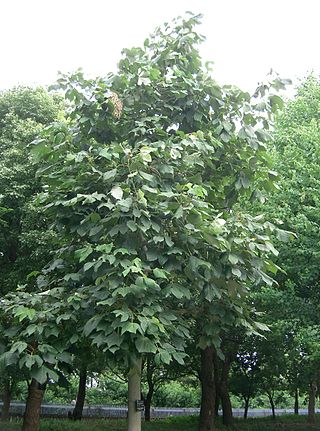Top Qs
Timeline
Chat
Perspective
Firmiana simplex
Species of tree From Wikipedia, the free encyclopedia
Remove ads
Firmiana simplex, commonly known as the Chinese parasol tree, Chinese parasoltree, or wutong (Chinese: 梧桐; pinyin: wútóng; jap.: godō), is a tree assigned to the family Malvaceae that was formerly in the family Sterculiaceae in the order Malvales, and is native to Asia. It grows up to 16 m (52 ft) tall.[2]

Remove ads
Description
It has alternate, deciduous leaves 15–30 cm (6–12 in) across, palmately lobed with three or five lobes, and small fragrant, greenish-white flowers borne in large inflorescences. A flowering tree varies in fragrance with weather and time of the day, having a lemony scent with citronella and chocolate tones. The flowers are pollinated by bees.[citation needed] The seedpod is like a pair of brown ovate leaves with seeds along the edges. Up to five pairs are produced by each flower.[3]
Remove ads
Uses
Due to its sonic properties, the wood is used for the soundboards of several Chinese instruments, including the guqin and guzheng.[citation needed]
The roasted seeds have reportedly been used to make into a tea.[4]
The Taivoan people in the Nanzixian River basin of Taiwan harvest the tough bark of 2–3-year-old trees. After soaking it by the river for about a month, they remove the rotted bark and twist the remaining fibers into ropes. These ropes can be used for making traps or other binding purposes, particularly for constructing wild boar traps. The robust nature of these ropes helps prevent the boars from escaping.[5]
Remove ads
Invasive species
It is grown as an ornamental tree in warm regions of North America; it has become an aggressive, invasive weed in the region.[6] It is self-fertile, and its seeds spread readily, especially along watercourses, growing rapidly after germination in favorable sites. The seedlings compete effectively with many other species.[7]
References
External links
Wikiwand - on
Seamless Wikipedia browsing. On steroids.
Remove ads

